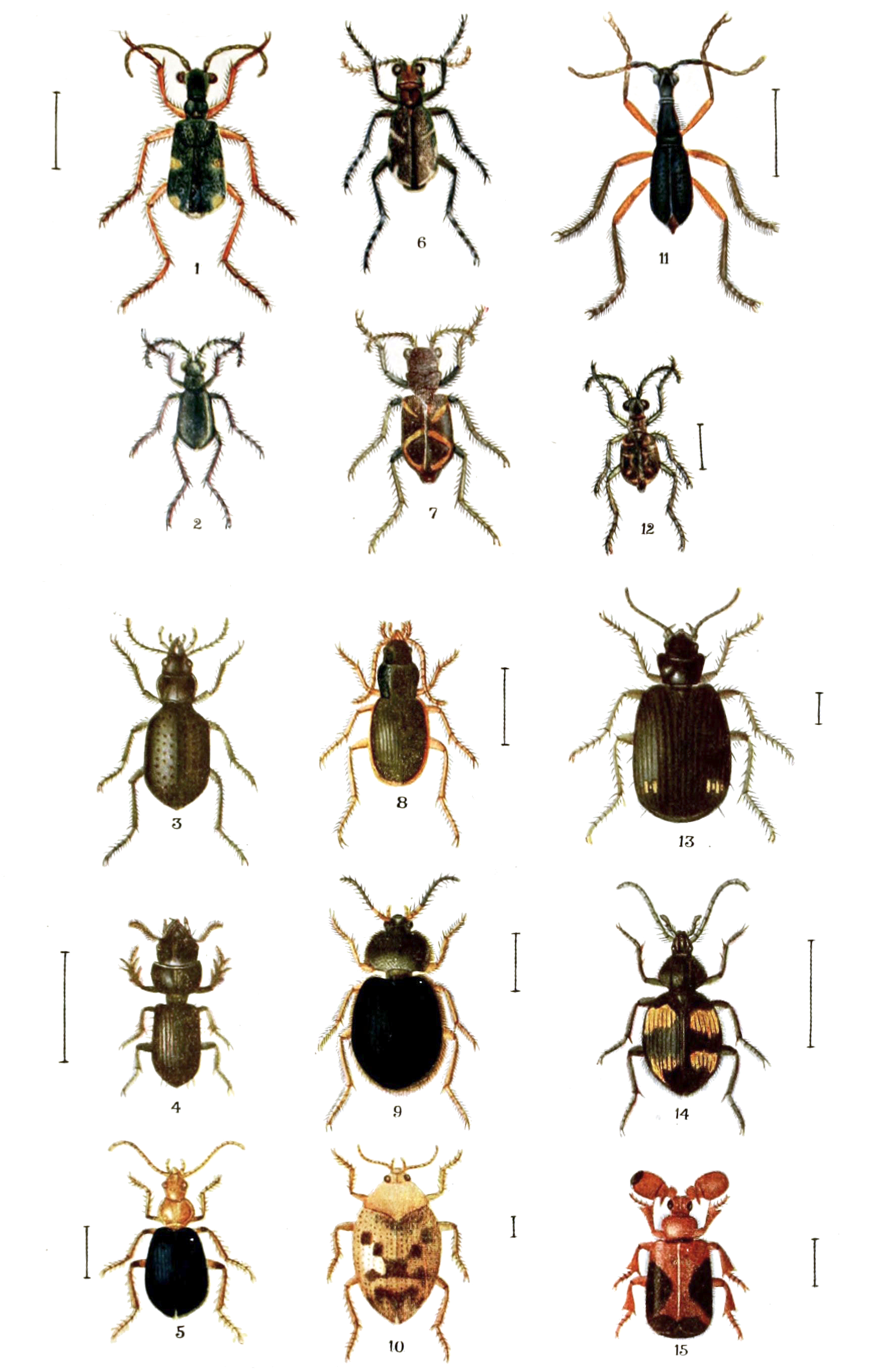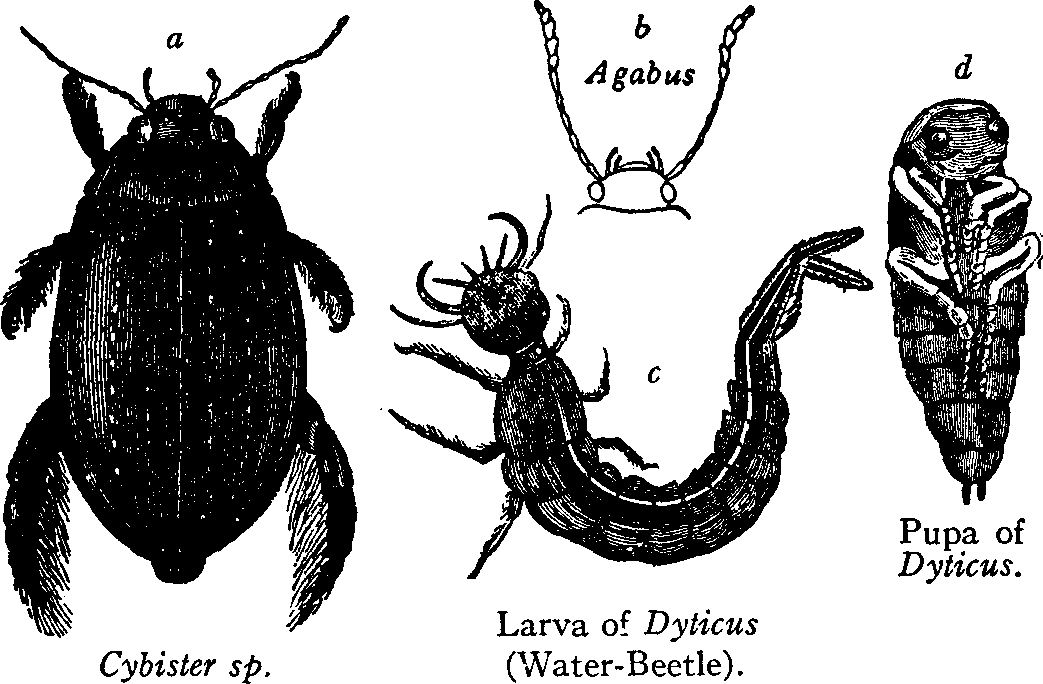|
Gyrinidae
The whirligig beetles are water beetles, comprising the family Gyrinidae that usually swim on the surface of the water if undisturbed, though they swim underwater when threatened. They get their common name from their habit of swimming rapidly in circles when alarmed, and are also notable for their divided eyes which are believed to enable them to see both above and below water. The family includes some 700 extant species worldwide, in 15 genera, plus a few fossil species. Most species are very similar in general appearance, though they vary in size from perhaps 3 mm to 18 mm in length. They tend to be flattened and rounded in cross section, in plain view as seen from above, and in longitudinal section. In fact their shape is a good first approximation to an ellipsoid, with legs and other appendages fitting closely into a streamlined surface. Whirligig beetles belong to the beetle suborder Adephaga, which also includes ground beetles and diving beetles. Description Wh ... [...More Info...] [...Related Items...] OR: [Wikipedia] [Google] [Baidu] |
Gyrininae
Gyrininae is a subfamily of ground and water beetles in the family Gyrinidae. There are at least 60 described species in Gyrininae. Genera Taxonomy after * Dineutini ** '' Cretodineutus'' - Burmese amber, Late Cretaceous ( Cenomanian) ** '' Cretogyrus'' - Burmese amber, Cenomanian ** '' Dineutus'' ** '' Enhydrus'' ** '' Macrogyrus'' (including '' Andogyrus'' ) ** '' Mesodineutes'' - Darmakan Formation, Russia, Danian The Danian is the oldest age or lowest stage of the Paleocene Epoch or Series, of the Paleogene Period or System, and of the Cenozoic Era or Erathem. The beginning of the Danian (and the end of the preceding Maastrichtian) is at the Cretace ... ** '' Miodineutes'' - Germany, Miocene ** '' Porrorhynchus'' * Gyrinini ** '' Aulonogyrus'' ** '' Gyrinoides'' ** '' Gyrinus'' ** '' Metagyrinus'' * Orectochilini ** '' Gyretes'' ** '' Orectochilus'' ** '' Orectogyrus'' ** '' Patrus'' * '' Chimerogyrus'' - Burmese amber, Cenomanian References ... [...More Info...] [...Related Items...] OR: [Wikipedia] [Google] [Baidu] |
Adephaga
The Adephaga (from Greek ἀδηφάγος, ''adephagos'', "gluttonous") are a suborder of beetles, and with more than 40,000 recorded species in 10 families, the second-largest of the four beetle suborders. Members of this suborder are collectively known as adephagans. The largest family is Carabidae (ground beetles) which comprises most of the suborder with over 40,000 species. Adephaga also includes a variety of aquatic beetles, such as predaceous diving beetles and whirligig beetles. Anatomy Adephagans have simple antennae with no pectination or clubs. The galeae of the maxillae usually consist of two segments. Adult adephagans have visible notopleural sutures. The first visible abdominal sternum is completely separated by the hind coxae, which is one of the most easily recognizable traits of adephagans. Five segments are on each foot. Wings The transverse fold of the hind wing is near the wing tip. The median nervure ends at this fold, where it is joined by a ... [...More Info...] [...Related Items...] OR: [Wikipedia] [Google] [Baidu] |
Spanglerogyrus
''Spanglerogyrus albiventris'' is a species of beetle in the family Gyrinidae The whirligig beetles are water beetles, comprising the family Gyrinidae that usually swim on the surface of the water if undisturbed, though they swim underwater when threatened. They get their common name from their habit of swimming rapidly i ..., the only species in the genus ''Spanglerogyrus''. It is native to North America, and was described in 1979 from specimens found in southern Alabama. It is the only living member of the subfamily Spanglerogyrinae, the earliest diverging extant lineage of the gyrinids which also includes '' Angarogyrus'' from the Jurassic and Cretaceous of Asia. References Gyrinidae Monotypic Adephaga genera {{Gyrinidae-stub ... [...More Info...] [...Related Items...] OR: [Wikipedia] [Google] [Baidu] |
Heterogyrus
''Heterogyrus milloti'' is a species of beetle in the family Gyrinidae, the only species in the genus ''Heterogyrus''. It is endemic to Madagascar, and forms a basal lineage within the family, estimated to have diverged from all other gyrinids (aside from the even earlier branching ''Spanglerogyrus ''Spanglerogyrus albiventris'' is a species of beetle in the family Gyrinidae The whirligig beetles are water beetles, comprising the family Gyrinidae that usually swim on the surface of the water if undisturbed, though they swim underwater w ...'') 200 million years ago. It is suggested to be closely related to the fossil genera '' Mesogyrus, Cretotortor'' and '' Baissogyrus'' which constitute the subfamily Heterogyrinae. References Gyrinidae Monotypic Adephaga genera {{Gyrinidae-stub ... [...More Info...] [...Related Items...] OR: [Wikipedia] [Google] [Baidu] |
Gyrinus Substriatus
''Gyrinus substriatus'' is a species of beetle native to Europe, the Near East, and North Africa. In Europe, it is only found in Austria, Belarus, Belgium, Bosnia and Herzegovina, Great Britain (incl. Isle of Man), Bulgaria, Croatia, the Czech Republic, mainland Denmark, Estonia, Finland, mainland France, Germany, mainland Greece, Hungary, Ireland, mainland Italy, Liechtenstein, North Macedonia, mainland Norway, Poland, mainland Portugal, Russia, Slovakia, Slovenia, mainland Spain, Sweden, Switzerland, the Netherlands, Ukraine and Yugoslavia Yugoslavia (; sh-Latn-Cyrl, separator=" / ", Jugoslavija, Југославија ; sl, Jugoslavija ; mk, Југославија ;; rup, Iugoslavia; hu, Jugoszlávia; rue, label=Pannonian Rusyn, Югославия, translit=Juhoslavija .... This is one of the most common species of whirligig beetle. References * * Gyrinidae Beetles of Asia Beetles of Europe Beetles described in 1829 {{Gyrinidae-stub ... [...More Info...] [...Related Items...] OR: [Wikipedia] [Google] [Baidu] |
Gyrinus Head1
''Gyrinus'' is a genus of small aquatic whirligig beetles in the family Gyrinidae native to the Palearctic (including Europe), the Near East, the Nearctic, North Africa, Asia Asia (, ) is one of the world's most notable geographical regions, which is either considered a continent in its own right or a subcontinent of Eurasia, which shares the continental landmass of Afro-Eurasia with Africa. Asia covers an are ... and Australia. Species These species belong to the genus ''Gyrinus'': References External links *''Gyrinus'' at Fauna Europaea {{Taxonbar, from=Q145824 Gyrinidae Adephaga genera Taxa named by Étienne Louis Geoffroy ... [...More Info...] [...Related Items...] OR: [Wikipedia] [Google] [Baidu] |
Water Beetles
A water beetle is a generalized name for any beetle that is adapted to living in water at any point in its life cycle. Most water beetles can only live in fresh water, with a few marine species that live in the intertidal zone or littoral zone. There are approximately 2000 species of true water beetles native to lands throughout the world. Many water beetles carry an air bubble, called the elytra cavity, underneath their abdomens, which provides an air supply, and prevents water from getting into the spiracles. Others have the surface of their exoskeleton modified to form a plastron, or "physical gill", which permits direct gas exchange with the water. Some families of water beetles have fringed hind legs adapted for swimming, but most do not. Most families of water beetles have larvae that are also aquatic; many have aquatic larvae and terrestrial adults. Diet Water beetles can be either herbivores, predators, or scavengers. Herbivorous beetles eat only aquatic vegetation, ... [...More Info...] [...Related Items...] OR: [Wikipedia] [Google] [Baidu] |
Tarsus (insect)
The arthropod leg is a form of jointed appendage of arthropods, usually used for walking. Many of the terms used for arthropod leg segments (called podomeres) are of Latin origin, and may be confused with terms for bones: ''coxa'' (meaning hip, plural ''coxae''), ''trochanter'', ''femur'' (plural ''femora''), ''tibia'' (plural ''tibiae''), ''tarsus'' (plural ''tarsi''), ''ischium'' (plural ''ischia''), ''metatarsus'', ''carpus'', ''dactylus'' (meaning finger), ''patella'' (plural ''patellae''). Homologies of leg segments between groups are difficult to prove and are the source of much argument. Some authors posit up to eleven segments per leg for the most recent common ancestor of extant arthropods but modern arthropods have eight or fewer. It has been argued that the ancestral leg need not have been so complex, and that other events, such as successive loss of function of a ''Hox''-gene, could result in parallel gains of leg segments. In arthropods, each of the leg segments ar ... [...More Info...] [...Related Items...] OR: [Wikipedia] [Google] [Baidu] |
Dytiscidae
The Dytiscidae – based on the Greek ''dytikos'' (δυτικός), "able to dive" – are the predaceous diving beetles, a family of water beetles. They occur in virtually any freshwater habitat around the world, but a few species live among leaf litter. The adults of most are between long, though much variation is seen between species. The European '' Dytiscus latissimus'' and Brazilian '' Megadytes ducalis'' are the largest, reaching up to and respectively. In contrast, the smallest is likely the Australian '' Limbodessus atypicali'' of subterranean waters, which only is about long. Most are dark brown, blackish, or dark olive in color with golden highlights in some subfamilies. The larvae are commonly known as water tigers due to their voracious appetite. They have short, but sharp mandibles and immediately upon biting, they deliver digestive enzymes into prey to suck their liquefied remains. The family includes more than 4,000 described species in numerous genera ... [...More Info...] [...Related Items...] OR: [Wikipedia] [Google] [Baidu] |
Gill
A gill () is a respiratory organ that many aquatic organisms use to extract dissolved oxygen from water and to excrete carbon dioxide. The gills of some species, such as hermit crabs, have adapted to allow respiration on land provided they are kept moist. The microscopic structure of a gill presents a large surface area to the external environment. Branchia (pl. branchiae) is the zoologists' name for gills (from Ancient Greek ). With the exception of some aquatic insects, the filaments and lamellae (folds) contain blood or coelomic fluid, from which gases are exchanged through the thin walls. The blood carries oxygen to other parts of the body. Carbon dioxide passes from the blood through the thin gill tissue into the water. Gills or gill-like organs, located in different parts of the body, are found in various groups of aquatic animals, including mollusks, crustaceans, insects, fish, and amphibians. Semiterrestrial marine animals such as crabs and mudskippers have gill ch ... [...More Info...] [...Related Items...] OR: [Wikipedia] [Google] [Baidu] |
Trachypachidae
The Trachypachidae (sometimes known as false ground beetles) are a family of beetles that generally resemble small ground beetles, but that are distinguished by the large coxae of their rearmost legs. There are only six known extant species in the family, with four species of '' Trachypachus'' found in northern Eurasia and northern North America, and two species of '' Systolosoma'' in Chile and Argentina. They were much more diverse in the past, with dozens of described species from the Mesozoic. Their habits are similar to those of the ground beetles; they are usually found in the leaf litter of conifer forests, and are thought to be mostly predators and scavengers, active during the day ( diurnal). According to entomologist George Ball, "the most interesting thing about this small family is its uncertain phylogenetic relationships"; it has previously been classified as a subfamily of Carabidae, and as a family been placed in several different positions relative to other beetl ... [...More Info...] [...Related Items...] OR: [Wikipedia] [Google] [Baidu] |







